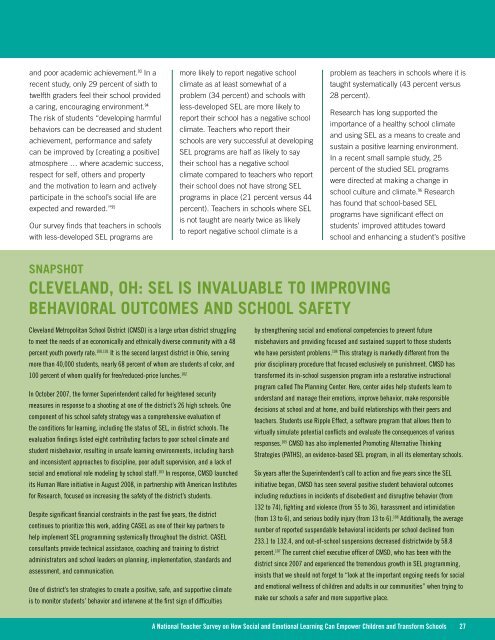the-missing-piece
the-missing-piece
the-missing-piece
Create successful ePaper yourself
Turn your PDF publications into a flip-book with our unique Google optimized e-Paper software.
and poor academic achievement. 93 In arecent study, only 29 percent of sixth totwelfth graders feel <strong>the</strong>ir school provideda caring, encouraging environment. 94The risk of students “developing harmfulbehaviors can be decreased and studentachievement, performance and safetycan be improved by [creating a positive]atmosphere … where academic success,respect for self, o<strong>the</strong>rs and propertyand <strong>the</strong> motivation to learn and activelyparticipate in <strong>the</strong> school’s social life areexpected and rewarded.” 95Our survey finds that teachers in schoolswith less-developed SEL programs aremore likely to report negative schoolclimate as at least somewhat of aproblem (34 percent) and schools withless-developed SEL are more likely toreport <strong>the</strong>ir school has a negative schoolclimate. Teachers who report <strong>the</strong>irschools are very successful at developingSEL programs are half as likely to say<strong>the</strong>ir school has a negative schoolclimate compared to teachers who report<strong>the</strong>ir school does not have strong SELprograms in place (21 percent versus 44percent). Teachers in schools where SELis not taught are nearly twice as likelyto report negative school climate is aproblem as teachers in schools where it istaught systematically (43 percent versus28 percent).Research has long supported <strong>the</strong>importance of a healthy school climateand using SEL as a means to create andsustain a positive learning environment.In a recent small sample study, 25percent of <strong>the</strong> studied SEL programswere directed at making a change inschool culture and climate. 96 Researchhas found that school-based SELprograms have significant effect onstudents’ improved attitudes towardschool and enhancing a student’s positiveSNAPSHOTCLEVELAND, OH: SEL IS INVALUABLE TO IMPROVINGBEHAVIORAL OUTCOMES AND SCHOOL SAFETYCleveland Metropolitan School District (CMSD) is a large urban district strugglingto meet <strong>the</strong> needs of an economically and ethnically diverse community with a 48percent youth poverty rate. 100,101 It is <strong>the</strong> second largest district in Ohio, servingmore than 40,000 students, nearly 68 percent of whom are students of color, and100 percent of whom qualify for free/reduced-price lunches. 102In October 2007, <strong>the</strong> former Superintendent called for heightened securitymeasures in response to a shooting at one of <strong>the</strong> district’s 26 high schools. Onecomponent of his school safety strategy was a comprehensive evaluation of<strong>the</strong> conditions for learning, including <strong>the</strong> status of SEL, in district schools. Theevaluation findings listed eight contributing factors to poor school climate andstudent misbehavior, resulting in unsafe learning environments, including harshand inconsistent approaches to discipline, poor adult supervision, and a lack ofsocial and emotional role modeling by school staff. 103 In response, CMSD launchedits Human Ware initiative in August 2008, in partnership with American Institutesfor Research, focused on increasing <strong>the</strong> safety of <strong>the</strong> district’s students.Despite significant financial constraints in <strong>the</strong> past five years, <strong>the</strong> districtcontinues to prioritize this work, adding CASEL as one of <strong>the</strong>ir key partners tohelp implement SEL programming systemically throughout <strong>the</strong> district. CASELconsultants provide technical assistance, coaching and training to districtadministrators and school leaders on planning, implementation, standards andassessment, and communication.One of district’s ten strategies to create a positive, safe, and supportive climateis to monitor students’ behavior and intervene at <strong>the</strong> first sign of difficultiesby streng<strong>the</strong>ning social and emotional competencies to prevent futuremisbehaviors and providing focused and sustained support to those studentswho have persistent problems. 104 This strategy is markedly different from <strong>the</strong>prior disciplinary procedure that focused exclusively on punishment. CMSD hastransformed its in-school suspension program into a restorative instructionalprogram called The Planning Center. Here, center aides help students learn tounderstand and manage <strong>the</strong>ir emotions, improve behavior, make responsibledecisions at school and at home, and build relationships with <strong>the</strong>ir peers andteachers. Students use Ripple Effect, a software program that allows <strong>the</strong>m tovirtually simulate potential conflicts and evaluate <strong>the</strong> consequences of variousresponses. 105 CMSD has also implemented Promoting Alternative ThinkingStrategies (PATHS), an evidence-based SEL program, in all its elementary schools.Six years after <strong>the</strong> Superintendent’s call to action and five years since <strong>the</strong> SELinitiative began, CMSD has seen several positive student behavioral outcomesincluding reductions in incidents of disobedient and disruptive behavior (from132 to 74), fighting and violence (from 55 to 36), harassment and intimidation(from 13 to 6), and serious bodily injury (from 13 to 6). 106 Additionally, <strong>the</strong> averagenumber of reported suspendable behavioral incidents per school declined from233.1 to 132.4, and out-of-school suspensions decreased districtwide by 58.8percent. 107 The current chief executive officer of CMSD, who has been with <strong>the</strong>district since 2007 and experienced <strong>the</strong> tremendous growth in SEL programming,insists that we should not forget to “look at <strong>the</strong> important ongoing needs for socialand emotional wellness of children and adults in our communities” when trying tomake our schools a safer and more supportive place.A National Teacher Survey on How Social and Emotional Learning Can Empower Children and Transform Schools 27


